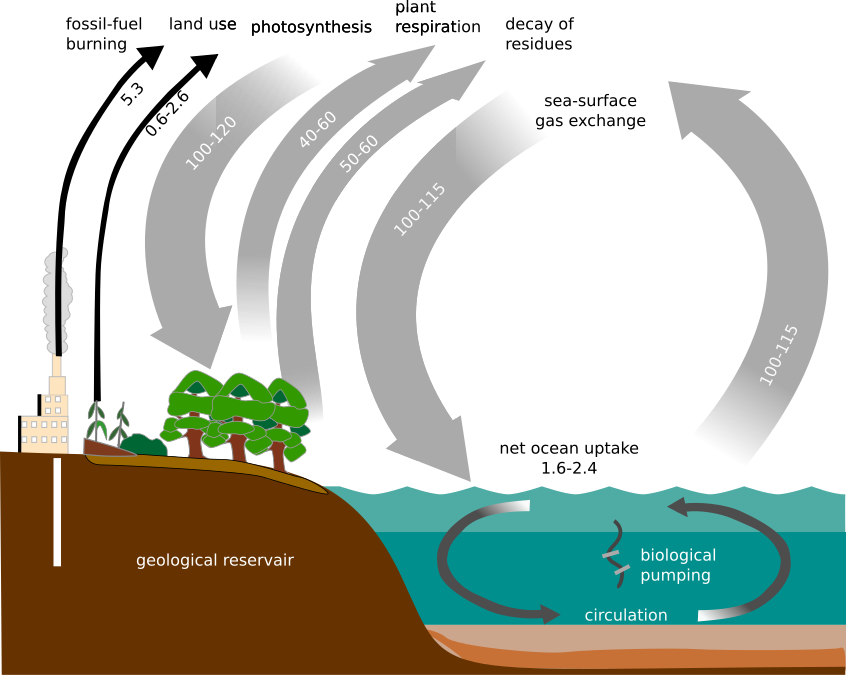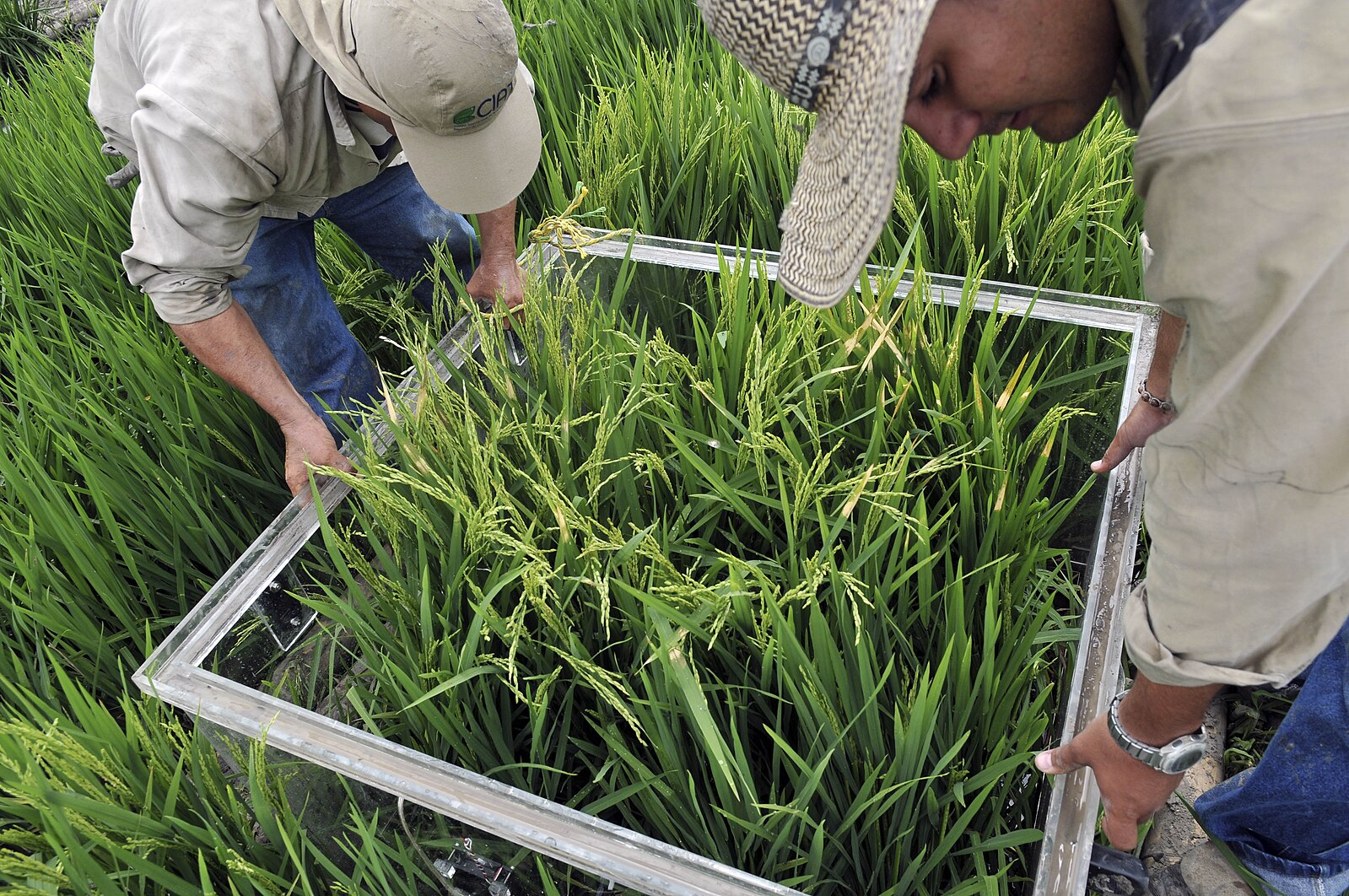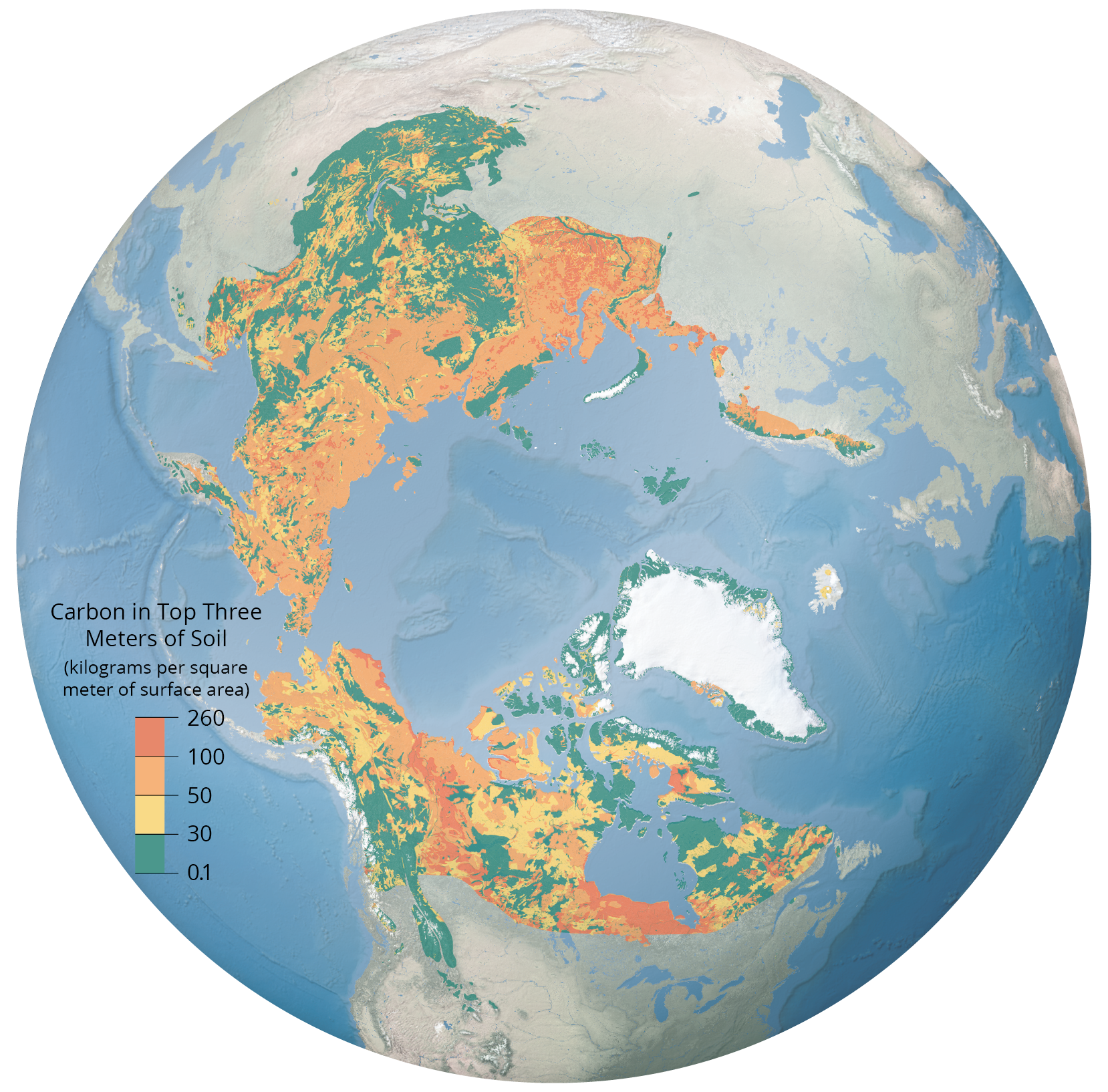IB Syllabus focus:
‘Soils act as sinks, stores or sources depending on inputs versus decomposition; warming, drainage and practices can release CO₂ or CH₄ and risk tipping points.’
Soils are crucial to the global carbon balance, functioning as both a reservoir and a regulator of greenhouse gases. Their management strongly influences climate change mitigation potential.
The Role of Soils in the Carbon Cycle
Soils are central to the carbon cycle, linking terrestrial ecosystems with the atmosphere. They contain more carbon than the atmosphere and vegetation combined. Soil carbon exists in two main forms:
Organic carbon: derived from decayed plants, animals, and microorganisms.
Inorganic carbon: mainly carbonates formed from mineral weathering.
Soils can sequester carbon when organic matter accumulates, or release carbon when decomposition outpaces inputs.

This diagram situates soils within the global carbon cycle, highlighting photosynthesis, plant litter inputs, soil respiration and decomposition that control sink–source behaviour. It supports the idea that net soil carbon balance depends on inputs versus outputs. The graphic also shows ocean processes, which are beyond this subsubtopic’s scope. Source.
Carbon Inputs to Soils
Carbon enters soils through processes such as:
Plant litter deposition (leaves, stems, roots).
Root exudates (organic compounds secreted into the soil).
Dead animal biomass.
Manure and compost in managed systems.
When these inputs exceed decomposition, soils function as carbon sinks.
Carbon Outputs from Soils
Carbon leaves soils in several ways:
Respiration: microbial decomposition releases carbon dioxide (CO₂).
Anaerobic conditions: waterlogged soils generate methane (CH₄) through microbial activity.
Erosion: physical removal of carbon-rich topsoil.
Leaching: dissolved organic carbon moving with percolating water.
Persistent losses may convert soils from sinks to sources.
Soil Management and Carbon Balance
Influence of Agricultural Practices
Farming systems directly alter soil carbon through:
Tillage: breaks down aggregates, increases aeration, and accelerates decomposition.
Monocropping: reduces diversity of organic inputs, lowering long-term carbon storage.
Use of fertilisers: stimulates plant growth but may indirectly affect microbial respiration.
Organic amendments: compost and manure can raise soil organic carbon stocks.
Climate Change and Soil Carbon
Warming and drainage significantly affect soil carbon storage.
Warming accelerates microbial respiration, releasing more CO₂.
Drainage of peatlands exposes previously waterlogged carbon stores, releasing both CO₂ and CH₄.
Permafrost thawing is a major tipping point, potentially releasing vast stores of carbon into the atmosphere.
Soil Carbon Pools
Soil carbon is stored in different pools with varying stability.
Active pool: rapidly decomposed, cycles in years (fresh litter, microbial biomass).
Slow pool: more resistant, cycles in decades (partially decomposed organic matter).
Passive pool: highly stable, cycles in centuries to millennia (humus, soil aggregates).
Humus: A stable, dark organic material formed from the decomposition of plant and animal matter, critical for nutrient and carbon storage.
The balance between these pools determines soil function in the carbon cycle.
Greenhouse Gas Fluxes from Soils
Carbon Dioxide (CO₂)
Produced through:
Microbial respiration during organic matter breakdown.
Root respiration from living plants.
Enhanced by higher temperatures and tillage.
Methane (CH₄)
Generated under anaerobic conditions:
Rice paddies are significant agricultural sources.

Researchers use a manually operated closed chamber to measure methane and carbon dioxide fluxes from flooded paddy soils, where anaerobic conditions favour methanogenesis. This directly illustrates how agricultural practices influence soil greenhouse gas outputs. The equipment detail exceeds the syllabus but clarifies how emissions evidence is obtained. Source.
Natural wetlands are the largest global emitters.
Nitrous Oxide (N₂O) and Soil Linkages
Though not carbon-based, N₂O relates to soil management and is relevant in the nitrogen cycle. Its release often accompanies carbon fluxes in fertilised soils.
Human Impacts on Soil Carbon Balance
Practices Increasing Soil Carbon Loss
Deforestation: removes vegetation inputs and accelerates erosion.
Urbanisation: seals soils, preventing carbon exchange.
Overgrazing: strips vegetation cover, leading to erosion and reduced organic input.
Practices Enhancing Soil Carbon Storage
Agroforestry: integrates trees to boost organic input and stabilise soils.
Cover crops: protect soil and add carbon-rich biomass.
Reduced tillage: preserves soil aggregates and slows decomposition.
Biochar application: stabilised carbon that resists decomposition.
Soils as Potential Tipping Points
Tipping points occur when a small change causes an irreversible shift in system behaviour. In soil systems, this can happen when:
Permafrost melts, releasing vast methane and carbon dioxide.

This circumpolar map depicts the amount of organic carbon stored in the top three metres of soil, emphasising vast high-latitude stocks that are vulnerable to thaw. Loss of permafrost integrity can accelerate CO₂ and CH₄ release, risking system-level tipping points. Colours indicate kilograms of carbon per square metre. Source.
Peatlands drain, turning long-term carbon sinks into sources.
Severe erosion irreversibly depletes soil organic matter.
These feedbacks can amplify global warming, making soils both victims and drivers of climate change.
Equations Relevant to Soil Carbon
Net Soil Carbon Balance (NSCB) = Inputs – Outputs
Inputs = Plant litter + Root exudates + Organic amendments
Outputs = CO₂ (respiration) + CH₄ (methanogenesis) + Leaching + Erosion
This balance determines whether a soil acts as a carbon sink or a carbon source.
Interactions with Other Cycles
Soil carbon links closely with the nitrogen cycle and water cycle. Moisture regulates microbial activity, while nitrogen availability controls decomposition and plant productivity. Integrated management is essential to maintain carbon balance.
FAQ
Soils act as long-term carbon sinks when organic matter becomes stabilised within aggregates or chemically bound to minerals. This reduces microbial access and slows decomposition.
Processes that enhance permanence include:
Formation of humus.
Protection of organic matter within clay particles.
Continuous input of litter from diverse vegetation.
Without these stabilising mechanisms, stored carbon can be released rapidly under warming or disturbance.
Peatlands accumulate organic matter because waterlogging slows decomposition. This results in very deep carbon stores compared with mineral soils.
When drained or disturbed, these soils release large quantities of CO₂ and CH₄, turning from long-term sinks into major greenhouse gas sources. Their vulnerability makes peatland conservation central to climate mitigation strategies.
Soil temperature directly regulates microbial activity.
Warmer soils increase enzyme activity, leading to faster decomposition and CO₂ release.
Cold or frozen soils slow microbial processes, preserving organic matter.
Rapid temperature fluctuations can destabilise permafrost, abruptly releasing stored carbon.
This sensitivity explains why high-latitude soils hold global significance under climate change.
Fine-textured soils (rich in clay and silt) protect carbon better than sandy soils. Clay particles bind organic compounds, limiting decomposition.
Sandy soils allow faster aeration and drainage, which speeds microbial breakdown. Thus, the same organic input can persist far longer in clay-rich soils than in sandy soils.
Carbon release from soils adds greenhouse gases to the atmosphere, strengthening the greenhouse effect.
Warming accelerates microbial activity, increasing soil CO₂ emissions.
More emissions amplify climate change, causing further warming.
In permafrost, this loop can become a tipping point, where carbon release is self-reinforcing and difficult to reverse.
Practice Questions
Question 1 (2 marks)
Explain why waterlogged soils are significant sources of methane (CH₄).
Mark scheme:
1 mark for recognising that waterlogging creates anaerobic conditions.
1 mark for explaining that anaerobic decomposition by methanogenic microbes produces methane.
Question 2 (5 marks)
Discuss how human activities can shift soils from being carbon sinks to carbon sources. Provide specific examples.
Mark scheme:
1 mark for stating that soils act as carbon sinks when inputs exceed decomposition.
1 mark for recognising that disturbance can increase decomposition and emissions.
1 mark for identifying deforestation (removal of vegetation inputs, increased erosion).
1 mark for identifying agricultural practices such as tillage or peatland drainage.
1 mark for linking these activities to increased CO₂ or CH₄ release.

